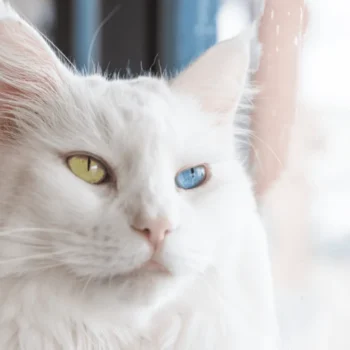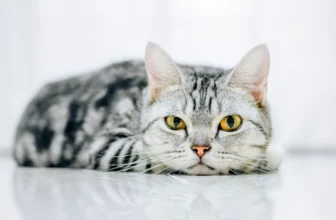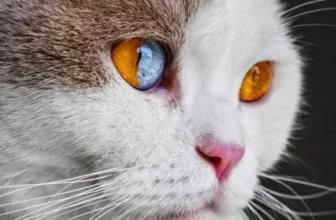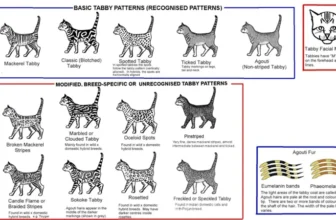The captivating allure of California Spangled cats is undeniable, from their distinctive spotted coats to their intelligent and social personalities. However, one of the most striking features of some California Spangled cats is their heterochromatic eyes. These captivating eyes add an enigmatic quality to an already intriguing breed, leaving many curious about their origin, significance, and care. In this article, we will explore the mysteries of heterochromatic eyes in California Spangled cats, including the science behind heterochromia, the reasons why some California Spangled cats have heterochromatic eyes, and the implications for their health and well-being. So, let’s dive into the world of heterochromatic eyes, where every cat has a unique story to tell.
What are heterochromatic eyes?
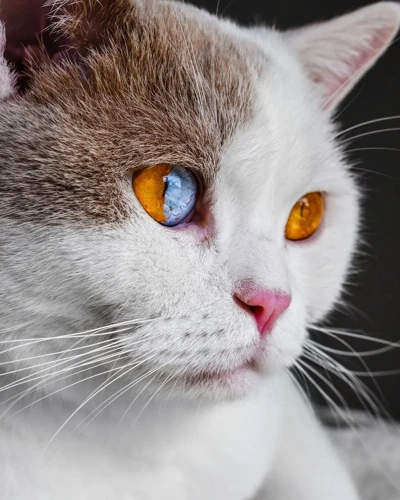
Heterochromatic eyes may sound like a mysterious, complex phenomenon, but they are actually quite simple: it’s when an individual has two eyes with different colors. Although it’s rare in humans, heterochromia is more common in animals, particularly in certain breeds of cats like the California Spangled cats. Have you ever wondered how heterochromatic eyes occur and why some felines have this unique trait? Let’s dive into the basics of heterochromia and learn more about this fascinating topic. You can also read more about the genetics behind the eye colors of California Spangled cats.
The basics of heterochromia
Heterochromia is a fascinating phenomenon in which an individual has eyes of two different colors. This condition is not limited to humans and can be seen in animals like dogs and cats. Heterochromia occurs due to the uneven distribution of melanin, the pigment responsible for giving color to our hair, skin, and eyes. It results in two different shades of eye color, such as one eye being brown and the other being blue.
There are two types of heterochromia: complete and partial. Complete heterochromia refers to a condition in which each eye has a different color completely, such as one eye being blue and the other being green. Whereas, partial heterochromia refers to a situation in which a part of one eye has a different color, such as a patch of blue in a mostly brown eye.
Moreover, heterochromia is common in some cat breeds like the California Spangled cats. These cats have a striking appearance with their unique coat patterns and mesmerizing eyes. Their eyes come in a range of colors including green, gold, and blue.
Heterochromia is not a health concern but rather a genetic condition. It may not cause any issues for the animal, but it might be a sign of other underlying health conditions that might require medical attention. In the following sections, we will explore why some California Spangled cats have heterochromatic eyes and the significance of heterochromatic eyes in these cats.
The difference between complete and partial heterochromia
Heterochromia is a condition in which one eye has a different color than the other or there is a variation of color within an eye. There are two types of heterochromia – complete and partial. Complete heterochromia is when one eye is completely different in color than the other eye such as one blue eye and one green eye. On the other hand, partial heterochromia is when there are two colors within the same eye, resulting in a unique and stunning appearance. This condition can occur in any breed of cat, including California Spangled cats.
It is interesting to note that while both types of heterochromia are considered rare, partial heterochromia is usually more common in cats than complete heterochromia. Rather than being caused by a genetic trait, it is thought that partial heterochromia occurs as a result of a random genetic mutation that takes place within the developmental stages of the eye.
California Spangled cats with heterochromatic eyes may have the complete form or partial form of the condition. However, regardless of which form they have, the unique appearance of their eyes is sure to mesmerize their human companions.
If you want to know more about different eye colors and patterns of California Spangled cats, you can read our article on Cali Spangled Cat Eye Colors.
Heterochromatic eyes in cats
Heterochromatic eyes in cats are a result of a genetic trait that causes the irises of the eyes to be different colors. This can be observed in many breeds of cats, including the California Spangled cat. Heterochromia can occur in one eye or both eyes.
Types of Heterochromia:
There are two types of heterochromia: complete and partial. Complete heterochromia is when one eye has a completely different color than the other eye. Partial heterochromia is when one eye has a portion of a different color within the iris.
The Prevalence of Heterochromatic Eyes in California Spangled Cats:
California Spangled cats are a breed that is known for their unique appearance and personalities. It is not uncommon for California Spangled cats to have heterochromatic eyes. In fact, some California Spangled cats have been specifically bred to have heterochromatic eyes, particularly blue and green/gold. However, it’s important to note that not all California Spangled cats have heterochromatic eyes and it’s not a requirement for their breed standard.
The Unique Beauty of Heterochromia:
Heterochromia is often considered a unique and beautiful trait in cats, including California Spangled cats. The combination of different colors in the eyes can be stunning and captivating, making the cats stand out. Some people even prefer cats with heterochromatic eyes and seek them out specifically.
If you’re interested in learning more about California Spangled cats and their eyes, check out our article on California Spangled cat eye colors or our article on blue eyes in California Spangled cats.
Why do some California Spangled cats have heterochromatic eyes?
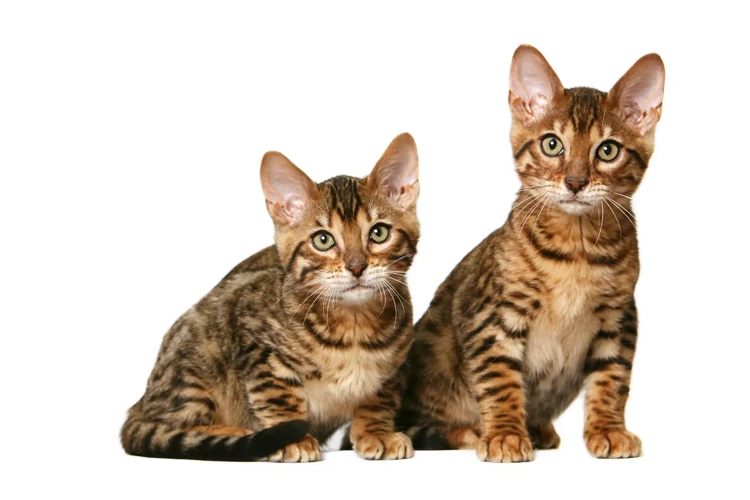
It’s fascinating how some California Spangled cats have eyes that are different colors from one another. This is known as heterochromia, and it’s a stunning phenomenon that has left many people curious about its causes. There are a few theories about why some California Spangled cats have heterochromatic eyes, ranging from genetics to melanin levels to coat patterns. In this section, we’ll delve into these theories and examine them in detail, so we can better understand this mysterious trait.
The genetics of heterochromia
Heterochromia is a genetic condition that causes differences in eye color within an individual. It can be complete or partial, affecting either one or both eyes. This condition is not limited to cats or any particular breed; it is also found in humans and other animals.
In simple terms, heterochromia in cats is caused by genetics. It occurs when there is an overexpression or underexpression of certain genes responsible for eye color. The cells responsible for producing eye color (called melanocytes) are regulated by genes that determine the amount and type of the pigment melanin.
There are several genes involved in determining eye color, including OCA2, TYR, TYRP1, and SLC24A4. Mutations in these genes can lead to melanin production issues, resulting in variations in eye color.
California Spangled cats are a breed that is particularly prone to heterochromia. According to feline genetics research, the allele combination for the Spangled is such that a heterozygous expression results in a greater tendency toward heterochromia. Additionally, because of their wild ancestry, it’s possible that they carry the White Spotting gene, which can also contribute to eye color variations.
It’s important to note that not all cats with heterochromatic eyes have a genetic mutation or illness. In fact, many cats simply inherit the condition from their parents or ancestors. However, in rare cases, it can be a sign of an underlying health issue, such as ocular melanoma or inflammation. It’s important to have your cat’s eyes regularly checked by a veterinarian to rule out any potential health concerns.
Caring for California Spangled cats with heterochromatic eyes requires regular check-ups and maintaining overall good health. While it may not be possible to prevent heterochromia, you can take steps to lessen its impact. The careful management of any underlying health issues, coupled with attention to eye care, nutrition, and UV protection, can help keep your fur baby’s eyes healthy and sparkling.
Understanding the role of melanin
Melanin is a pigment that plays a critical role in determining the color of the skin, hair, and eyes. In the context of heterochromia, melanin is particularly important because it affects the amount of pigment in different parts of the iris, which can result in variations in eye color.
The amount of melanin in the iris is primarily determined by genetics. Genes control the production, transport, and storage of melanin. The more melanin there is in a cat’s iris, the darker their eye color will be. Conversely, if there is less melanin in the iris, the eye color will be lighter.
The role of melanin in eye color is particularly relevant to California Spangled cats, who are known for displaying a wide range of eye colors, including heterochromatic eyes. When it comes to heterochromatic eyes, it’s common for one eye to have more melanin than the other. This variation in melanin concentrations results in eyes of different colors.
In addition to determining eye color, melanin also plays a role in protecting the eyes from the harmful effects of UV radiation. Light-colored eyes are more susceptible to damage from the sun’s rays because they have less melanin to absorb the UV light. This is something that California Spangled cat owners should be aware of when it comes to caring for their pets’ eyes.
There is some evidence to suggest that the amount of melanin in a cat’s eyes may change as they age. While it is not uncommon for a cat’s eye color to lighten a bit as they age, it is important to note that this can also be a sign of eye problems, such as cataracts or glaucoma. Regular eye check-ups are essential to ensure that any health issues are caught early and treated promptly.
Ultimately, the role of melanin in determining eye color is fascinating and complex. While genetics play a significant role in eye color, other factors, such as melanin concentration, can also contribute to variations in eye color and heterochromia. Owners of California Spangled cats with heterochromatic eyes should be mindful of their pets’ eye health and take steps to ensure that they receive the proper care and attention they need.
The link between eye color and coat pattern
Did you know that there is a link between the eye color and coat pattern in California Spangled cats? This fascinating connection has been a topic of interest in the feline world for quite some time. The California Spangled cat is known for its unique coat patterns, which can range from spotted to striped and everything in between. But did you know that the cat’s eye color can also vary based on its coat pattern?
Tabby Patterns and Eye Colors
California Spangled cats with classic tabby patterns, which include bold, swirling stripes, often have bright gold or green eyes. On the other hand, those with a mackerel tabby pattern, which consists of thin stripes, typically have deep, intense green eyes. Interestingly, if a California Spangled cat has a spotted tabby pattern, it commonly has heterochromatic eyes.
Spotted Patterns and Eye Colors
A cat with the classic spotted pattern, which features large, round spots, can have eyes that range from gold to hazel. These cats typically have a well-rounded face with large eyes that perfectly complement their spotted coat. Additionally, the coat color of spotted California Spangled cats can vary. Some may have a silver coat, while others have black, brown, or even orange.
Marbled Patterns and Eye Colors
California Spangled cats with a marbled pattern, which consists of a swirling, marble-like design, often have striking amber eyes. These cats have a unique appearance that sets them apart from other breeds, as the marbled pattern is less common.
The connection between the eye color and coat pattern of California Spangled cats is just one of the intriguing aspects of these rare felines. If you want to learn more about the beauty of amber eyes in California Spangled cats, or how the eyes of these cats change with age, be sure to check out our related articles here and here. Or, if you want to learn more about the different eye colors you may see in California Spangled cats, check out our article on Cali spangled cat eye colors.
The prevalence of heterochromatic eyes in California Spangled cats
According to recent studies, heterochromia is a rare trait and it’s estimated that only around 1% of the general population has heterochromatic eyes. However, some breeds of cats have a higher prevalence of heterochromatic eyes.
One such breed is the California Spangled cat, which has been known to have a higher than average occurrence of heterochromia. In fact, it’s estimated that up to 20% of California Spangled cats have heterochromatic eyes.
This high prevalence could be due to the breed’s unique genetics and ancestry. California Spangled cats were originally bred from various wild cats, including the Asian Leopard Cat, which may have contributed to the higher occurrence of heterochromatic eyes. Additionally, breeding practices over the years could have also played a role in selecting for heterochromia in the breed.
It’s important to note that while heterochromia is more common in California Spangled cats compared to other breeds, not all California Spangled cats have heterochromatic eyes. Factors such as individual genetics and environmental influences can also play a role in eye coloration.
The significance of heterochromatic eyes in California Spangled cats
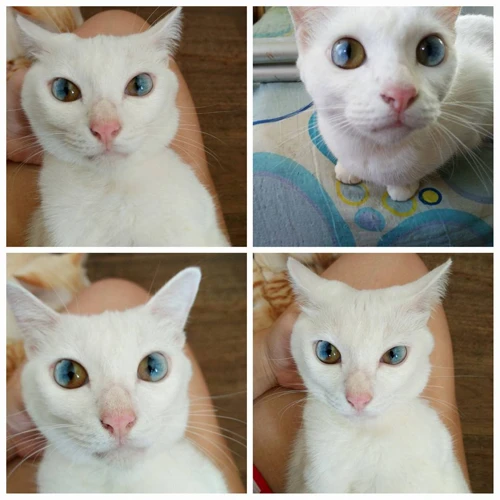
There’s something truly mesmerizing about heterochromatic eyes in California Spangled cats. The way their eyes seem to hold different worlds within them can cause anyone to stop and stare in awe. But, beyond their striking appearance, do these oddities have any significance in these felines? What implications can heterochromatic eyes hold for the health and well-being of these gorgeous creatures? Let’s explore the mystery further.
The unique beauty of heterochromia
Heterochromatic eyes are undeniably striking and unique, and when it comes to California Spangled cats, they add an extra touch of exotic beauty to these already majestic felines. One of the most notable features of heterochromia is the way it can create a mesmerizing contrast between the two different eye colors. This contrast can be especially pronounced in California Spangled cats, where the eyes often have earthy shades of brown, yellow, or green, combined with bright blue or turquoise.
The fact that heterochromia is relatively rare, with only a small percentage of cats and humans exhibiting this trait, adds to the unique allure of these cats. It’s hard not to be captivated by the striking gaze of a cat with heterochromatic eyes, and many people are drawn to these cats for their distinctive beauty.
One interesting aspect of heterochromatic eyes in California Spangled cats is how the condition can highlight the specific features of the cat’s coat pattern. For example, a cat with a spotted coat pattern may have eyes that perfectly complement the spots, creating a cohesive and visually pleasing look. This is just one of the ways that heterochromatic eyes can add to the overall aesthetic appeal of a California Spangled cat.
Heterochromia is often associated with positive qualities such as uniqueness, creativity, and intelligence. This can make California Spangled cats with heterochromatic eyes even more appealing to those who value those traits in their pets.
The unique beauty of heterochromatic eyes adds to the charm and allure of California Spangled cats, making them a highly desirable breed among cat lovers. The contrast between the different eye colors combined with the specific coat pattern of the cat can create a mesmerizing visual effect that is hard to ignore.
The potential health implications of heterochromatic eyes
Heterochromatic eyes in cats are generally considered a harmless trait that adds to their unique and mesmerizing appearance. However, studies have shown that certain health implications may be associated with heterochromia.
| Health Implication | Description |
|---|---|
| Increased sensitivity to sunlight | Cats with heterochromatic eyes, especially those with blue or light-colored irises, are more susceptible to damage from ultraviolet (UV) rays. This can lead to issues such as photokeratitis (sunburn of the cornea) and even cataracts. |
| Potential vision problems | In some cases, heterochromia can be associated with abnormalities in the structure or function of the eye. These may include cataracts, glaucoma, and retinal problems. Regular eye check-ups are important to catch any potential issues early on. |
| Increased risk of deafness | Heterochromia is sometimes seen in cats with white coat patterns, which are also associated with higher rates of congenital deafness. However, not all cats with white coats and heterochromatic eyes are deaf, and not all deaf cats have heterochromia. |
It’s important to note that these health implications are not exclusive to California Spangled cats with heterochromatic eyes, but can be seen in any cat breed with this trait. Thus, it’s important for cat owners to be vigilant about their pets’ eye health and take preventative measures when necessary, such as providing UV protection and scheduling regular check-ups with a veterinarian.
Caring for California Spangled cats with heterochromatic eyes
As a pet owner, caring for a California Spangled cat with heterochromatic eyes may seem daunting at first. It’s natural to have questions about how to properly care for their unique eyes to ensure their long-term health and well-being. Luckily, with a little knowledge and guidance, caring for a cat with heterochromia can be a relatively easy and straightforward process. In this section, we will explore the various aspects of caring for California Spangled cats with heterochromatic eyes, from regular eye check-ups to UV protection, and more. So, let’s dive in and explore how to properly care for these beautiful feline companions.
Regular eye check-ups and care
Ensuring your California Spangled cat with heterochromatic eyes maintains good eye health is essential in order to prevent any potential health issues from arising. Regular check-ups with a veterinarian are crucial to ensure that any eye problems are detected in their early stages.
How often should you take your cat for eye check-ups?
It is generally recommended to take your cat for a check-up at least once a year. However, if your California Spangled cat has a history of eye health issues, it may be necessary to schedule more frequent check-ups with your veterinarian.
What should you expect during a regular eye check-up?
During a check-up, your veterinarian will examine your cat’s eyes for any signs of abnormality or disease. They may use specialized equipment, such as an ophthalmoscope, to examine the inner structures of your cat’s eye. The veterinarian will also assess your cat’s vision and eye health by performing tests such as the Schirmer tear test, which measures the production of tears.
At-home eye care for your cat
In addition to regular check-ups with your veterinarian, it is important to provide your California Spangled cat with regular at-home eye care. This includes gently cleaning their eyes with a soft, damp cloth to remove any discharge or debris that may have accumulated. Regular cleaning also allows you to observe any changes in your cat’s eyes, such as redness or swelling, which may indicate a health issue.
What should you do if you notice any issues?
If you notice any changes in your cat’s eyes, such as redness, swelling, or discharge, it is important to contact your veterinarian immediately. Addressing any health issues early on can lead to better treatment outcomes and prevent any potential complications.
Taking care of your California Spangled cat’s eye health through regular check-ups and at-home care can ensure they continue to enjoy their unique heterochromatic eyes for years to come.
| Regular Eye Check-ups and Care |
|---|
| Ensure to take your cat for a check-up at least once a year |
| If your cat has a history of eye health issues, schedule more frequent check-ups with your veterinarian |
| During a check-up, your veterinarian will examine your cat’s eyes for any signs of abnormality or disease |
| At-home eye care includes gently cleaning their eyes with a soft, damp cloth to remove any discharge or debris that may have accumulated |
| If you notice any changes in your cat’s eyes, such as redness, swelling, or discharge, contact your veterinarian immediately |
Addressing underlying health issues
When caring for California Spangled cats with heterochromatic eyes, it is essential to address any underlying health issues that may be causing the condition. This is because heterochromia can sometimes be a symptom of an underlying health problem. It is important to take note if there are any changes in your cat’s eye color, as it could signify a health concern.
Common health issues that can lead to heterochromatic eyes in cats
There are several health issues that may cause heterochromatic eyes in cats. These include:
| Health Issue | Symptoms | Treatment |
|---|---|---|
| Uveitis (inflammation of the iris) | Eye redness, cloudiness, pain, sensitivity to light, reduced vision | Treatment of the underlying cause, medication (e.g., anti-inflammatory drugs) and sometimes surgery if the inflammation is severe |
| Glaucoma (increased pressure within the eye) | Eye redness, cloudiness, pain, enlarged pupil, visual impairment, blindness | Treatment to reduce the intraocular pressure, such as medication or surgery, depending on the severity of the condition |
| Feline leukemia virus (FeLV) | Weight loss, lethargy, anemia, diarrhea, vomiting, eye infections | There is no specific treatment for FeLV, treatment focuses on management of symptoms and supportive care, such as aggressive fluid and nutritional therapy, blood transfusions. |
Regular veterinary check-ups
It is essential to take your cat for regular veterinary check-ups, particularly if they have heterochromatic eyes. This will help diagnose any underlying health issues that may be causing the condition. Your vet will examine your cat’s eyes and perform tests, such as measuring intraocular pressure, to rule out any eye-related issues.
Preventive measures
While not all underlying health issues are preventable, there are some steps you can take to reduce the risk of some of them. For example, keeping your cat indoors, feeding them a healthy and balanced diet and keeping them up to date with their vaccinations.
Addressing underlying health issues in California Spangled cats with heterochromatic eyes is crucial for their overall health and wellbeing. Regular veterinary check-ups and preventive measures can help ensure their eyes remain healthy and clear, promoting a happy and healthy life for your furry friend.
UV protection for cats with light-colored eyes
Cats with light-colored eyes, including those with heterochromatic eyes, are at increased risk of developing damage from UV radiation. The sun emits harmful UV rays that can cause photokeratitis, a painful inflammation of the eyes. This is particularly concerning for outdoor cats, as they are exposed to the sun for extended periods of time.
To protect your California Spangled cat’s eyes from UV damage, it’s important to take certain precautions. One effective method is to limit your cat’s exposure to direct sunlight during the brightest times of day, typically between 10 a.m. and 4 p.m. If your cat enjoys spending time outdoors during these hours, provide a shaded area for them to relax in. It’s also recommended to never expose cats with light-colored eyes to tanning beds, as they are highly dangerous for their eyes.
Another important measure is to provide your cat with UV-protective eyewear. Yes, you read it correctly! They make cat sunglasses and goggles on the market. The sunglasses are designed to block harmful UV rays and are available in a variety of sizes, colors, and styles. Cats may take a little time to get used to the glasses, so be sure to offer plenty of positive reinforcement and patience.
For those who don’t want to invest in sunglasses for their cat, there are alternative methods of UV protection, such as applying a small amount of sunblock around the edges of the cat’s eyes – always make sure to use sunblock made for cats to avoid any harmful chemicals. It’s important to note that sunblock should NEVER be applied directly into a cat’s eyes.
Finally, it’s essential to be vigilant about monitoring your cat’s eye health and schedule regular check-ups with a veterinarian. If you notice any concerning symptoms or changes in your California Spangled cat’s eyes, such as redness, swelling, or discharge, seek veterinary attention immediately. With proper precautions and care, your cat can enjoy the outdoors comfortably and safely!
| UV Protection Tips for Cats with Light-Colored Eyes |
|---|
| Limit exposure to direct sunlight during the brightest times of day (between 10 a.m. and 4 p.m.) to reduce the risk of eye damage. |
| Provide a shaded area for your cat to rest if they enjoy spending time outdoors during peak sunlight hours. |
| Consider investing in UV-protective eyewear specifically designed for cats. |
| Apply a small amount of cat-safe sunblock around the edges of your cat’s eyes. |
| Never expose cats with light-colored eyes to tanning beds, as they can be highly dangerous for their eyes. |
| Monitor your cat’s eye health and schedule regular check-ups with a veterinarian to catch any potential issues early. |
The importance of nutrition for eye health
A well-balanced diet is essential for the overall health of your California Spangled cat, including their eye health. Providing your cat with the right nutrients can help prevent eye problems and maintain healthy vision.
Here are some important nutrients for eye health:
| Nutrient | Source | Benefits |
|---|---|---|
| Vitamin A | Liver, cod liver oil, eggs, and dairy products | Helps prevent night blindness and maintain healthy vision |
| Vitamin C | Citrus fruits, green leafy vegetables, and berries | Helps prevent cataracts and macular degeneration |
| Vitamin E | Nuts, seeds, and vegetable oils | Protects eyes against free radicals and oxidative damage |
| Omega-3 Fatty Acids | Salmon, sardines, tuna, and flaxseed | Helps prevent dry eyes and improve tear quality |
| Lutein and Zeaxanthin | Spinach, kale, and other green leafy vegetables | Helps protect against macular degeneration and cataracts |
It is important to note that while a balanced diet can provide these essential nutrients, excessive amounts of certain vitamins can also be harmful to your cat’s health. Consult with your veterinarian to determine the appropriate amount and type of food to feed your California Spangled cat for optimal eye health.
Conclusion
In conclusion, heterochromatic eyes in California Spangled cats are truly a fascinating and mysterious occurrence. While the reasons behind their unique eye colors may not be fully understood, it is clear that genetics and melanin play a significant role in their development.
Despite the potential health concerns that come with light-colored eyes, owners of California Spangled cats with heterochromatic eyes need not worry excessively. Regular eye check-ups, addressing underlying health issues, and providing UV protection can help mitigate any potential problems.
Furthermore, it is important to appreciate and celebrate the unique beauty that heterochromatic eyes bring to these already stunning cats. They truly are a wonder of nature and add an extra layer of charm to an already beloved breed.
In caring for California Spangled cats with heterochromatic eyes, owners must remember to prioritize eye health through proper nutrition and regular check-ups. This will not only ensure that their cat remains healthy and happy, but also that their eyes continue to shine bright for years to come.
In summary, while there may still be many mysteries surrounding heterochromatic eyes in California Spangled cats, it is clear that they are a unique and beautiful aspect of this beloved breed. Owners can take comfort in knowing that with proper care and attention, their cat can continue to thrive and capture the hearts of cat lovers everywhere.
Frequently Asked Questions
What causes heterochromatic eyes in cats?
Heterochromatic eyes are caused by a genetic mutation that affects the distribution of melanin in the iris. This mutation results in one eye having a different color than the other.
Are California Spangled cats the only breed that can have heterochromatic eyes?
No, heterochromatic eyes can occur in any breed of cat. However, California Spangled cats are known to have a higher incidence of this trait.
Do all California Spangled cats have heterochromatic eyes?
No, not all California Spangled cats have heterochromatic eyes. However, it is a commonly seen trait in this breed.
Can heterochromatic eyes in cats be a sign of health problems?
In some cases, heterochromatic eyes can be a sign of underlying health issues such as Waardenburg syndrome or deafness. However, it is not always the case.
Is it painful for cats to have heterochromatic eyes?
No, it is not painful for cats to have heterochromatic eyes. It is simply a cosmetic difference.
Should I be concerned if my California Spangled cat has heterochromatic eyes?
Not necessarily. Heterochromatic eyes are usually harmless, but it is important to maintain regular eye check-ups to ensure there are no underlying health issues.
Can heterochromatic eyes in cats change over time?
No, the color of a cat’s eyes will not change over time. However, the appearance of heterochromatic eyes may change as the cat ages and their eye color becomes more distinct.
What can I do to protect my California Spangled cat’s eyes?
Eyes should be regularly checked and any underlying health issues should be addressed. As well, cats with light-colored eyes should be provided with UV protection when outdoors to prevent eye damage.
Do California Spangled cats with heterochromatic eyes require special care?
No, California Spangled cats with heterochromatic eyes do not require special care. However, regular eye check-ups should be maintained and any health issues should be addressed promptly.
Is heterochromatic eyes in cats a rare trait?
Heterochromatic eyes are not extremely rare in cats, but they are less common than cats with the same color eyes. California Spangled cats are known to have a higher incidence of this trait.

